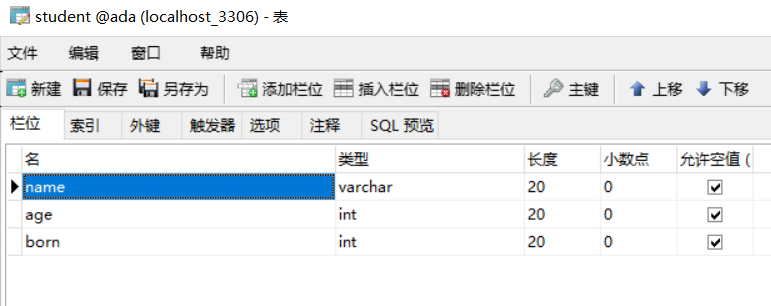JDBC连接池
JDBC连接池
概念:其实就是一个容器(集合),存放数据库连接的容器。
当系统初始化好后,容器被创建,容器中会申请一些连接对象,当用户来访问数据库时,从容器中获取连接对象,用户访问完之后,会将连接对象归还给容器。好处:
- 节约资源
- 用户访问高效
实现:
标准接口:DataSource javax.sql包下的
方法:
获取连接:getConnection()
归还连接:Connection.close()。
如果连接对象Connection是从连接池中获取的,那么调用Connection.close()方法,则不会再关闭连接了。而是归还连接
一般我们不去实现它,由数据库厂商来实现
- C3P0:数据库连接池技术
- Druid:数据库连接池实现技术,由阿里巴巴提供的
C3P0
数据库连接池技术
- 步骤:
- 导入jar包 (两个) c3p0-0.9.5.2.jar mchange-commons-java-0.2.12.jar
- 不要忘记导入数据库驱动jar包
- 定义配置文件:
- 名称: c3p0.properties 或者 c3p0-config.xml
- 路径:直接将文件放在src目录下即可。
- 创建核心对象 数据库连接池对象 ComboPooledDataSource
4. 获取连接: getConnection代码实现
配置文件
<c3p0-config> <!-- 使用默认的配置读取连接池对象 --> <default-config> <!-- 连接参数 --> <property name="driverClass">com.mysql.jdbc.Driver</property> <property name="jdbcUrl">jdbc:mysql://localhost:3306/ada</property> <property name="user">root</property> <property name="password">admin</property> <!-- 连接池参数 --> <!--初始化申请的连接数量--> <property name="initialPoolSize">5</property> <!--最大的连接数量--> <property name="maxPoolSize">10</property> <!--超时时间--> <property name="checkoutTimeout">3000</property> </default-config> <!--自定义配置--> <named-config name="otherc3p0"> <!-- 连接参数 --> <property name="driverClass">com.mysql.jdbc.Driver</property> <property name="jdbcUrl">jdbc:mysql://localhost:3306/ada</property> <property name="user">root</property> <property name="password">admin</property> <!-- 连接池参数 --> <property name="initialPoolSize">5</property> <property name="maxPoolSize">8</property> <property name="checkoutTimeout">1000</property> </named-config> </c3p0-config>测试代码
public class Demo1 { public static void main(String[] args) throws SQLException { //获得连接池对象 不传值使用默认配置 DataSource dataSources = new ComboPooledDataSource(); /*传值使用自定义配置 *DataSource dataSources = new ComboPooledDataSource("otherc3p0"); */ //获得链接对象 Connection connection = dataSources.getConnection(); //打印 System.out.println(connection); //归还连接 connection.close(); } }

Druid
数据库连接池实现技术,由阿里巴巴提供的
* 步骤: 1. 导入jar包 druid-1.0.9.jar 2. 定义配置文件: - 是properties形式的 - 可以叫任意名称,可以放在任意目录下 3. 加载配置文件。Properties 4. 获取数据库连接池对象:通过工厂来来获取 DruidDataSourceFactory 5. 获取连接:getConnection
- 代码实现
配置文件
driverClassName=com.mysql.jdbc.Driver url=jdbc:mysql://localhost:3306/ada username=root password=admin # 初始化连接数量 initialSize=5 # 最大连接数 maxActive=10 # 最大等待时间 maxWait=3000测试
public class TestDemo2 { public static void main(String[] args) throws Exception { Properties properties = new Properties(); //加载配置文件 TestDemo2 testDemo2 = new TestDemo2(); InputStream resourceAsStream = testDemo2.getClass().getClassLoader().getResourceAsStream("druid.properties"); properties.load(resourceAsStream); DataSource dataSource = DruidDataSourceFactory.createDataSource(properties); Connection connection = dataSource.getConnection(); System.out.println(connection); } }
- 定义工具类
- 定义一个类 JDBCUtils
- 提供静态代码块加载配置文件,初始化连接池对象
- 提供方法
- 获取连接方法:通过数据库连接池获取连接
- 释放资源
- 获取连接池的方法
代码:
public class JDBCUtils { private static DataSource dataSource; static { try { //加载配置文件 Properties properties = new Properties(); properties.load(JDBCUtils.class.getClassLoader().getResourceAsStream("druid.properties")); //获取DateSource dataSource = DruidDataSourceFactory.createDataSource(properties); } catch (IOException e) { e.printStackTrace(); } catch (Exception e) { e.printStackTrace(); } } /** * 获取链接 */ public static Connection getConnection() throws SQLException { return dataSource.getConnection(); } /** * 归还连接 * @param resultSet * @param statement * @param connection */ public static void close(ResultSet resultSet, Statement statement, Connection connection) { if (resultSet != null) { try { resultSet.close(); } catch (SQLException e) { e.printStackTrace(); } } if (statement != null) { try { statement.close(); } catch (SQLException e) { e.printStackTrace(); } } if (connection != null) { try { connection.close();//归还链接 } catch (SQLException e) { e.printStackTrace(); } } } /** * @param statement * @param connection */ public static void close(Statement statement, Connection connection) { close(null, statement, connection); } /** * * @return 连接池 */ public static DataSource getDataSource(){ return dataSource; } }
- 测试工具类
public class Demo3 { public static void main(String[] args) { Connection connection = null; PreparedStatement pstm = null; try { //获得连接 connection = JDBCUtils.getConnection(); //定义sql String sql = "insert into student values('5',?,?)"; pstm = connection.prepareStatement(sql); pstm.setInt(1, 23); pstm.setInt(2, 34); int i = pstm.executeUpdate(); if (i > 0) { System.out.println("成功"); } else { System.out.println("失败"); } }catch (SQLException e) { e.printStackTrace(); } finally { //释放走远 JDBCUtils.close(pstm, connection); } } }
Spring JDBC
Spring框架对JDBC的简单封装。提供了一个JDBCTemplate对象简化JDBC的开发
步骤:
导入jar包
创建JdbcTemplate对象。依赖于数据源DataSource
JdbcTemplate template = new JdbcTemplate(ds);
调用JdbcTemplate的方法来完成CRUD的操作
- update():执行DML语句。增、删、改语句
- queryForMap():查询结果将结果集封装为map集合,将列名作为key,将值作为value 将这条记录封装为一个map集合
- 注意:这个方法查询的结果集长度只能是1
- queryForList():查询结果将结果集封装为list集合
- 注意:将每一条记录封装为一个Map集合,再将Map集合装载到List集合中
- query():查询结果,将结果封装为JavaBean对象
- query的参数:RowMapper
- 一般我们使用BeanPropertyRowMapper实现类。可以完成数据到JavaBean的自动封装
- new BeanPropertyRowMapper<类型>(类型.class)
- queryForObject:查询结果,将结果封装为对象
- 一般用于聚合函数的查询
测试
public class JT { public static void main(String[] args) { JdbcTemplate template = new JdbcTemplate(JDBCUtils.getDataSource()); String sql = "update student set name='小明' where name=?"; int count = template.update(sql, "3"); System.out.println(count); } }练习:
- 需求:
- 修改1号数据的 age为 21
- 添加一条记录
- 删除刚才添加的记录
- 查询id为1的记录,将其封装为Map集合
- 查询所有记录,将其封装为List
- 查询所有记录,将其封装为Emp对象的List集合
- 查询总记录数
代码:
创建持久化类
public class Emp { private String name; private Integer age; private Integer born; public String getName() { return name; } public void setName(String name) { this.name = name; } public Integer getAge() { return age; } public void setAge(Integer age) { this.age = age; } public Integer getBorn() { return born; } public void setBorn(Integer born) { this.born = born; } @Override public String toString() { return "Emp{" + "name='" + name + '\'' + ", age=" + age + ", born=" + born + '}'; } }测试代码:
public class JTTest { JdbcTemplate jdbcTemplate; @Before public void before() { jdbcTemplate = new JdbcTemplate(JDBCUtils.getDataSource()); } /** * 更新 */ @Test public void test1() { int update = jdbcTemplate.update("update student set age=21 where name ='1'"); System.out.println(update); } /** * 添加记录 */ @Test public void test2() { String sql = "insert into student values(?,?,?)"; int update = jdbcTemplate.update(sql, "6", 6, 6); System.out.println(update); } /** * 删除 */ @Test public void test3() { String sql = "delete from student where name= ? "; int update = jdbcTemplate.update(sql, "6"); System.out.println(update); } /** * 查询 * 注意:queryForMap查询的结果集只能为1 */ @Test public void test4() { String sql = "select * from student where age=?"; Map<String, Object> map = jdbcTemplate.queryForMap(sql, 23); Set<Map.Entry<String, Object>> entrySet = map.entrySet(); Iterator<Map.Entry<String, Object>> iterator = entrySet.iterator(); while (iterator.hasNext()) { Map.Entry<String, Object> next = iterator.next(); System.out.println(next.getKey() + " " + next.getValue()); } } /** * queryForList查询 */ @Test public void test5() { String sql = "select * from student where age=?"; List<Map<String, Object>> maps = jdbcTemplate.queryForList(sql, 100); System.out.println(maps); } @Test public void test6_1() { String sql = "select * from student"; List<Emp> list = jdbcTemplate.query(sql, new RowMapper<Emp>() { @Override public Emp mapRow(ResultSet resultSet, int i) throws SQLException { Emp emp = new Emp(); emp.setName(resultSet.getString("name")); emp.setAge(resultSet.getInt(2)); emp.setBorn(resultSet.getInt(3)); return emp; } }); System.out.println(list); } @Test public void test6_2() { String sql = "select * from student"; List<Emp> query = jdbcTemplate.query(sql, new BeanPropertyRowMapper<Emp>(Emp.class)); for (Emp emp : query ) { System.out.println(emp); } } /** * 查询总计录数 */ @Test public void test7() { String sql = "SELECT COUNT(*) FROM STUDENT "; Long aLong = jdbcTemplate.queryForObject(sql, Long.class); System.out.println(aLong); } }


